Unit 12 Life is full of the unexpected 第2课时 考点讲解(共20张PPT)
文档属性
| 名称 | Unit 12 Life is full of the unexpected 第2课时 考点讲解(共20张PPT) |  | |
| 格式 | pptx | ||
| 文件大小 | 1.4MB | ||
| 资源类型 | 试卷 | ||
| 版本资源 | 人教新目标(Go for it)版 | ||
| 科目 | 英语 | ||
| 更新时间 | 2021-07-13 15:13:51 | ||
图片预览



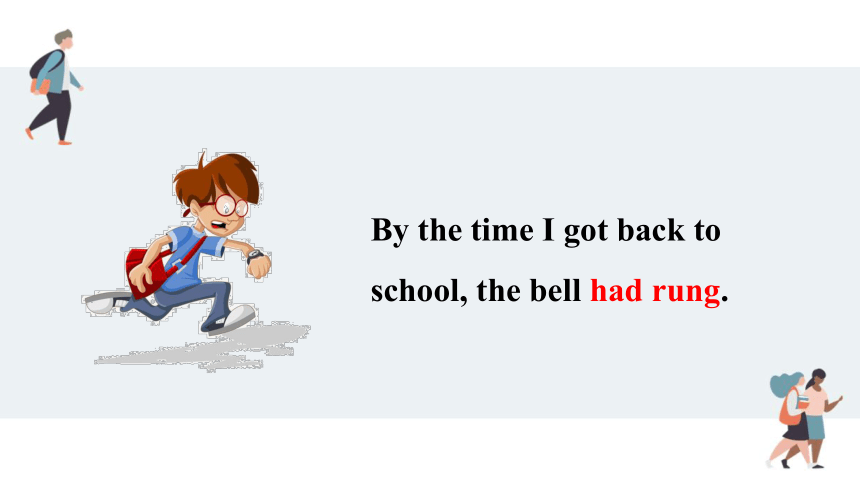
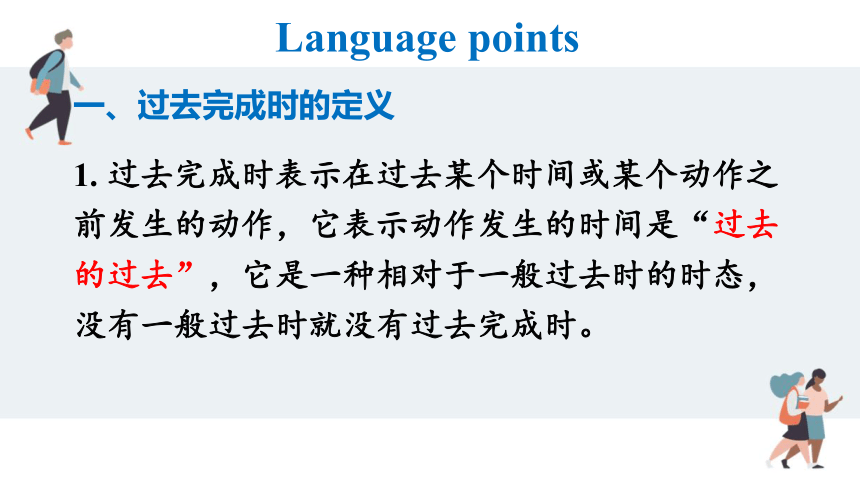
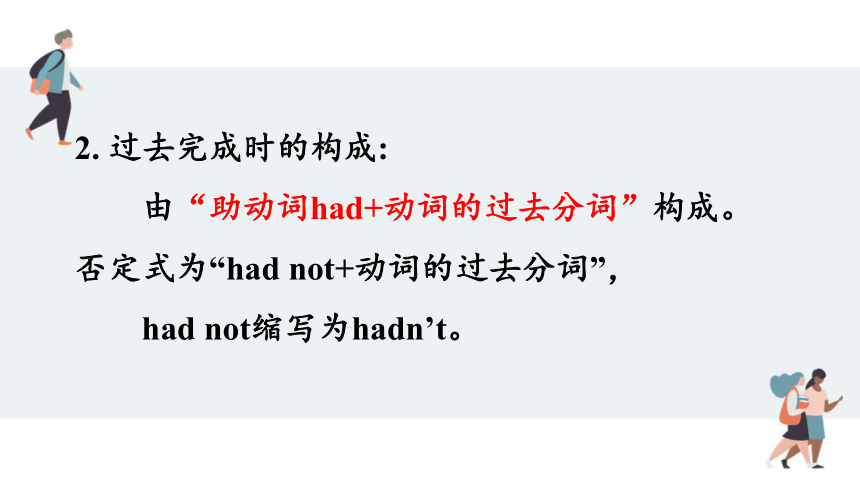

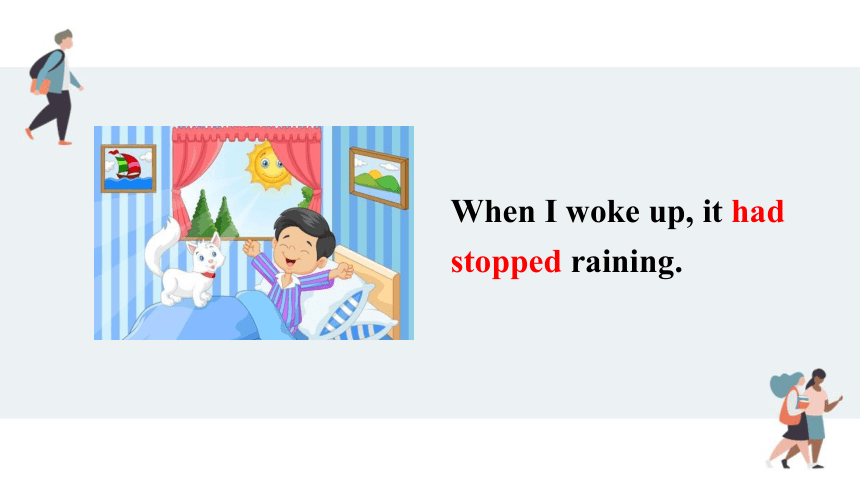
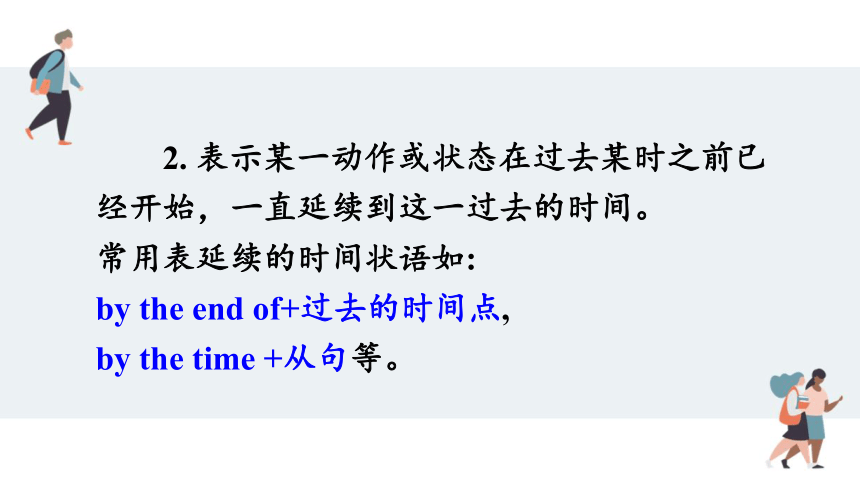
文档简介
Unit 12 Life is full of the unexpected.
R·九年级全一册
第二课时
Life is Full of the Unexpected.
Have you ever experienced anything unexpected?
Lead in
When I got to school, I realized that I had left my backpack at home.
By the time I got back to school, the bell had rung.
1. 过去完成时表示在过去某个时间或某个动作之前发生的动作,它表示动作发生的时间是“过去的过去”,它是一种相对于一般过去时的时态,没有一般过去时就没有过去完成时。
Language points
一、过去完成时的定义
2. 过去完成时的构成:
由“助动词had+动词的过去分词”构成。
否定式为“had not+动词的过去分词”,
had not缩写为hadn’t。
二、过去完成时的用法:
1. 表示一动作或状态在过去某一时间或动作之前已经完成,即发生在“过去的过去”。
这个过去的时间可以用by, before等介词短语或者一个时间状语从句来表示。
When I woke up, it had stopped raining.
2. 表示某一动作或状态在过去某时之前已经开始,一直延续到这一过去的时间。
常用表延续的时间状语如:
by the end of+过去的时间点,
by the time +从句等。
By the end of last year, she had worked in the factory for twenty years.
三、过去完成时的判断依据:
1. 由时间状语来判定
①by+过去的时间点
②by the end of+过去的时间点
2. 由“过去的过去”来判定
①含有宾语从句的复合句:
当主句为一般过去时,
且从句的动作先于主句的动作发生时,从句要用过去完成时。
如在told, said, knew, heard, thought等动词后的宾语从句中。
She said that she had seen the film before.
②含有状语从句的复合句:
主、从句的动作发生有先后关系,
动作在后的要用一般过去时,
动作在前的要用过去完成时。
Before I got to the bus stop, the bus had already left.
③表示意向的动词,如hope, wish, expect,
think, intend, mean, suppose等,用过去
完成时表示“原本……,但未能”。
We had hoped that you would come yesterday, but you didn’t.
I'm sorry, but I had to do my homework.
When I got to the bus stop, the bus ________
already ________.
A. has; left?? B. had; left????
C. has; been away?? D. had; been away
B
Practice
Summary
1.过去完成时的意义
2.过去完成时的构成: had (not) done
3.过去完成时的用法
4.过去完成时的判断依据
(1)由时间状语来判定
(2)由“过去的过去”来判定
(3)根据上下文来判定
THANKS
R·九年级全一册
第二课时
Life is Full of the Unexpected.
Have you ever experienced anything unexpected?
Lead in
When I got to school, I realized that I had left my backpack at home.
By the time I got back to school, the bell had rung.
1. 过去完成时表示在过去某个时间或某个动作之前发生的动作,它表示动作发生的时间是“过去的过去”,它是一种相对于一般过去时的时态,没有一般过去时就没有过去完成时。
Language points
一、过去完成时的定义
2. 过去完成时的构成:
由“助动词had+动词的过去分词”构成。
否定式为“had not+动词的过去分词”,
had not缩写为hadn’t。
二、过去完成时的用法:
1. 表示一动作或状态在过去某一时间或动作之前已经完成,即发生在“过去的过去”。
这个过去的时间可以用by, before等介词短语或者一个时间状语从句来表示。
When I woke up, it had stopped raining.
2. 表示某一动作或状态在过去某时之前已经开始,一直延续到这一过去的时间。
常用表延续的时间状语如:
by the end of+过去的时间点,
by the time +从句等。
By the end of last year, she had worked in the factory for twenty years.
三、过去完成时的判断依据:
1. 由时间状语来判定
①by+过去的时间点
②by the end of+过去的时间点
2. 由“过去的过去”来判定
①含有宾语从句的复合句:
当主句为一般过去时,
且从句的动作先于主句的动作发生时,从句要用过去完成时。
如在told, said, knew, heard, thought等动词后的宾语从句中。
She said that she had seen the film before.
②含有状语从句的复合句:
主、从句的动作发生有先后关系,
动作在后的要用一般过去时,
动作在前的要用过去完成时。
Before I got to the bus stop, the bus had already left.
③表示意向的动词,如hope, wish, expect,
think, intend, mean, suppose等,用过去
完成时表示“原本……,但未能”。
We had hoped that you would come yesterday, but you didn’t.
I'm sorry, but I had to do my homework.
When I got to the bus stop, the bus ________
already ________.
A. has; left?? B. had; left????
C. has; been away?? D. had; been away
B
Practice
Summary
1.过去完成时的意义
2.过去完成时的构成: had (not) done
3.过去完成时的用法
4.过去完成时的判断依据
(1)由时间状语来判定
(2)由“过去的过去”来判定
(3)根据上下文来判定
THANKS
同课章节目录
- Unit 1 How can we become good learners.
- Section A
- Section B
- Unit 2 I think that mooncakes are delicious!
- Section A
- Section B
- Unit 3 Could you please tell me where the restroom
- Section A
- Section B
- Unit 4 I used to be afraid of the dark.
- Section A
- Section B
- Unit 5 What are the shirts made of?
- Section A
- Section B
- Review of Units 1-5
- Unit 6 When was it invented?
- Section A
- Section B
- Unit 7 Teenagers should be allowed to choose their
- Section A
- Section B
- Unit 8 It must belong to Carla.
- Section A
- Section B
- Unit 9 I like music that I can dance to.
- Section A
- Section B
- Unit 10 You're supposed to shake hands.
- Section A
- Section B
- Review of Units 6-10
- Unit 11 Sad movies make me cry.
- Section A
- Section B
- Unit 12 Life is full of the unexpected
- Section A
- Section B
- Unit 13 We're trying to save the earth!
- Section A
- Section B
- Unit 14 I remember meeting all of you in Grade 7.
- Section A
- Section B
- Review of Units 11-14
